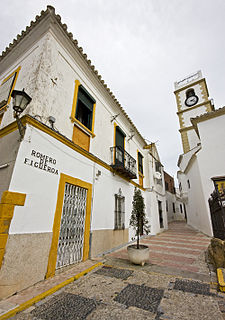
An apostolic vicariate is a territorial jurisdiction of the Catholic Church under a titular bishop centered in missionary regions and countries where dioceses or parishes have not yet been established. It is essentially provisional, though it may last for a century or more. The hope is that the region will generate sufficient numbers of Catholics for the Church to create a diocese. In turn, the status of apostolic vicariate is often a promotion for a former apostolic prefecture, while either may have started out as a mission sui iuris.

The Catholic Diocese of Honolulu, officially in Latin Diœcesis Honoluluensis, is an ecclesiastical territory or particular church of the Catholic Church in the United States. The diocese comprises the entire state of Hawaiʻi and the unincorporated Hawaiian Islands.
A titular bishop in various churches is a bishop who is not in charge of a diocese. By definition, a bishop is an "overseer" of a community of the faithful, so when a priest is ordained a bishop, the tradition of the Catholic, Eastern Orthodox and Oriental Orthodox churches is that he be ordained for a specific place. There are more bishops than there are functioning dioceses. Therefore, a priest appointed not to head a diocese as its diocesan bishop but to be an auxiliary bishop, a papal diplomat, or an official of the Roman Curia is appointed to a titular see.

The Cathedral of Saint Mary the Crowned is a Roman Catholic cathedral in Gibraltar. It is the primary centre of Catholic worship in the Diocese of Gibraltar.

The hierarchy of the Catholic Church consists of its bishops, priests, and deacons. In the ecclesiological sense of the term, "hierarchy" strictly means the "holy ordering" of the Church, the Body of Christ, so to respect the diversity of gifts and ministries necessary for genuine unity.

The Roman Catholic Archdiocese of Liverpool is an archdiocese of the Catholic Church that covers the Isle of Man and part of North West England. The episcopal see is Liverpool Metropolitan Cathedral. The Archdiocese is the centre of the Ecclesiastical Province of Liverpool which covers the north of England as well as the Isle of Man.

The Roman Catholic Archdiocese of Southwark is a Roman Catholic archdiocese of the Latin Rite in England. The archepiscopal see is headed by the Archbishop of Southwark. The archdiocese is part of the Metropolitan Province of Southwark, which covers the South of England. The cathedral church is St George's Cathedral, Southwark.
The Apostolic Vicariate of the London District was an ecclesiastical jurisdiction of the Roman Catholic Church in England and Wales. It was led by a vicar apostolic who was a titular bishop. The apostolic vicariate was created in 1688 and was dissolved in 1850 and its former area was replaced by the episcopal sees of Westminster and Southwark.
Peter Emmanuel Amigo was a Roman Catholic bishop in the Catholic Church in England and Wales. He founded The John Fisher School in 1929.

The Roman Catholic Diocese of Gibraltar is a diocese of the Latin Church of the Roman Catholic Church in the British overseas territory of Gibraltar. The Latin name for the diocese is Dioecesis Gibraltariensis. About twenty priests and nine sisters serve in the diocese. Carmelo Zammit was installed as bishop on 24 September 2016. At just over 6 square kilometers, it is among the smallest of all Catholic dioceses in the world.

Bishop William Wareing was the first Roman Catholic Bishop of the Diocese of Northampton.

Juan Romero de Figueroa was a Spanish Roman Catholic priest, in charge of the Parish Church of St. Mary the Crowned during the last years of Gibraltar's Spanish period and first ones of the British period, until his death. He remained at his post even after the territory's capture by an Anglo-Dutch fleet in 1704 on behalf of the Archduke Charles, pretender to the Spanish throne in the War of the Spanish Succession, when most of its population abandoned Gibraltar.

James Yorke Bramston was an English-born bishop of the Roman Catholic Church. He served as Vicar Apostolic of the London District from 1827 until his death in 1836.

Our Lady of Europe is a title given to the Blessed Virgin Mary patroness of Gibraltar and protectress of Europe. The entire European continent was consecrated under the protection of Our Lady of Europe in the early 14th century from the Shrine in Gibraltar where devotion continues to this day, over 700 years on.

John Baptist Scandella STD was a Gibraltarian Roman Catholic priest of Genoese descent. He was Vicar Apostolic of the Diocese of Gibraltar between 1857 and 1880. He spoke fluent English and his native Spanish. Scandella is mainly remembered in Gibraltar for seeing the return of the statue of Our Lady of Europe to Gibraltar from Algeciras in Spain and for his efforts to improve education in the territory.

Edward Rapallo was the third Gibraltarian born Roman Catholic Bishop of Gibraltar following in the footsteps of Bishop Scandella and his successor Bishop Canilla.

Sacred Heart Church is a Catholic church in Gibraltar.

The Apostolic Vicariate of Asmara was a Roman Catholic missionary jurisdiction in Eritrea. Centered in Asmara it was at first the Apostolic Prefecture of Eritrea and then the Apostolic Vicariate of Eritrea.

Francisco Xavier Ricardo Vilá y Mateu, O.F.M.Cap. was a Spanish prelate of the Roman Catholic Church and a member of the Order of Friars Minor Capuchin. He arrived as Guam's first bishop in 1911, and serving as apostolic vicar for less than a year, dying on 1 January 1913.














